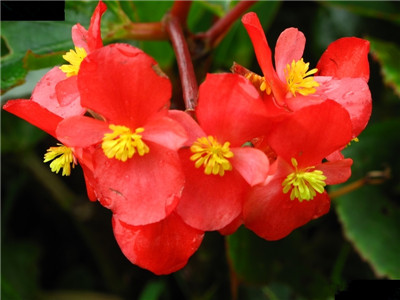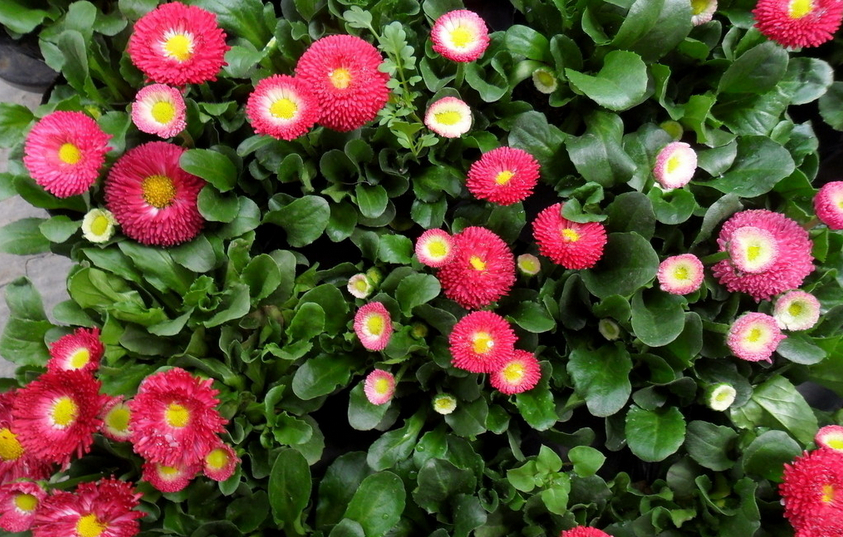How to raise four Seasons Begonia?
Crabapple flowers in four seasons have been loved by many people, so many people raise them in their own homes. There are many varieties of crabapple flowers in the four seasons, which have the advantages of round plant type, many and dense flowers, easy to plant with other flower bed plants, and long flowering and ornamental period in the four seasons. The following editor introduces the breeding methods of begonia in the next four seasons.
First, basin soil, the four seasons begonia basin soil is the most ideal mixture of river sand, rotten leaf soil and snake shavings. Begonia in the four seasons is afraid of the heat, so it should be kept in a cool place in summer.
The four seasons crabapple likes warm and moist conditions, so during the growth period, it should be watered according to the plant growth and temperature changes. Less watering during the budding period, keep the basin soil slightly dry, if too wet will lead to rotting roots. During the growing period, water is watered every two days, and water is often sprayed around the plant to increase air humidity. In addition, it should be noted that when watering, do not water the leaves and the top of the stem, but along the edge of the flowerpot, otherwise the stems and leaves are prone to water rot.
Third, fertilization, the four seasons crabapple during the growth period should be according to the plant leaf color and leaf growth quietly apply fertilizer, can not fertilize too much, otherwise it will lead to excessive leaf growth, affecting flowering. Appropriate amount of phosphate and potash fertilizer should be applied before flowering to improve flowering quality.
Fourth, when winter comes, we should dig up the bulbs and hang them in a dry and ventilated place or put the potted flowers in a warm indoor place to survive the winter.

Fifth, disease prevention, four seasons crabapple in the high temperature drying period, prone to root rot and stem rot. At the initial stage of discovery, watering should be controlled in time, and carbendazim should be sprayed to control it. Continuous use for a period of time can see the curative effect.
Sixth, winter and summer management, due to the influence of temperature in winter and summer, the growth of begonia is relatively slow, so it is necessary to strengthen the management of fertilizer and water.
Seventh, sunshine, in the hot summer season, we must avoid the four seasons crabapple by the direct light, so that it will sunburn the four seasons crabapple.
Eighth, the four Seasons Begonia after the flower fade-must remember to remove the heart in time, get rid of the residual flowers, so that it can grow more luxuriantly.
The common pest is the leaf roll moth, which eats the young leaves and flowers with its larvae, which directly affects the growth and development of the four seasons crabapple. For this situation, if it is not particularly serious, it can be caught by people. For serious cases, use dimethoate diluent to spray wine.
The flowerpots of crabapple should be placed on the balcony or courtyard in the semi-shade at ordinary times, do not let direct sunlight come in, and pay attention to ventilation. After planting crabapple for half a month, you can apply a mature fat and water, and during the later growth period, apply a light fat and water every 20-30 days, put it indoors in winter and place it in a sunny place, and the lowest temperature should not be less than 10 degrees.
How to raise Begonia in four Seasons
Four Seasons Begonia is a relatively easy to raise flowers, the following editor for you to introduce the breeding methods of four Seasons Begonia, welcome to read.
How to raise Begonia in four Seasons
1. Moderate watering
Four seasons crabapple likes the humid environment, but in the hot summer, the basin soil should be slightly moist. Watering should not be fixed several times a day or once a few days, but should pay attention to observe the dry and wet condition of the basin soil at any time. It can be watered when the basin soil turns white, and the amount of water should not be too much. Watering time around 9 o'clock is better, as far as possible not dry, watering thoroughly, but can not wait until completely dry again.
2. Classified fertilization
The summer fertilization of four seasons begonia should be treated differently according to the new and old plants. For the new plants propagated in the autumn of the previous year, some mature thin cake fertilizer and water can be applied after each stubble, and the suitable fertilizer-water ratio is 1:5, once a week, twice a week, and can blossom again after two weeks. When the temperature is above 25 ℃, the old perennial plants or weakly growing plants should stop fertilization and wait until after the summer to usher in the second peak flowering season.
3. Cooling and humidification
The temperature is high and the air is dry in summer. in addition to shading and ventilation, it is necessary to sprinkle water on the ground around the plant many times a day to reduce the temperature and increase the air humidity. Families with conditions can set up a sand bed in a corner of the balcony or a corner of the courtyard, put the plant on the sand surface or sit on the sand bed, and wet the sand while watering the plant. in this way, it can play a better role in cooling and humidifying.
4. Disease prevention and insect control
Begonia is prone to spot bacteriosis under the condition of high temperature and high humidity. At first, dark brown spots appeared on the leaf surface, and gradually spread to a dark brown rib. The same amount of Bordeaux solution can be used to prevent the disease before the disease, and pay attention to improve the cultivation conditions and management methods. In the early stage of the disease, the diseased leaves should be removed and burned in time to prevent re-spread. Summer is the high incidence period of aphids and red spiders, so it is necessary to control them with pollution-free pesticides in time.
How to raise Begonia in four Seasons
How to raise four Seasons Begonia? is it poisonous?
As a potted flower, four Seasons Begonia is not only one of the household ornaments, but also can be used as the preferred flower species to decorate the garden. Very adorable, how to raise the four seasons crabapple? Is four Seasons Begonia poisonous? Next, let's tell you.
Brief introduction of four Seasons Begonia:
Four seasons begonia, alias; four seasons begonia, clam crabapple, Latin name: Begonia semperflorens Link etOtto. Begonia, Begonia is a fleshy herb. Roots fibrous; stems erect, fleshy, glabrous, base much branched, leafy. Leaves ovate or broadly ovate, base slightly oblique, margin serrated and eyelashes, bright green on both sides, but main veins usually reddish. Originally from Brazil. Begonia is the most common and cultivated species of begonia. Graceful, delicate and bright leaves, flowers in clusters, blooming in the four seasons, and with a slight fragrance, is one of the main potted flowers for indoor and outdoor decoration. People apply it to the layout of flower beds, and the effect is excellent. With the emergence of some relatively heat-resistant varieties, Begonia is likely to become one of the most important flower beds in China, with the advantages of round plant type, many and dense flowers, easy to plant with other flower bed plants, long ornamental period and so on. so it's becoming more and more popular. It is generally cultivated in spring and autumn.
How to raise four Seasons Begonia?
1. Ecological habits: the four seasons crabapple prefers warm and humid climate, semi-overcast and sandy loam environment rich in humus, loose and good permeability. Afraid of the cold and. High temperature, the suitable temperature is 18-25 ℃.
2. Watering: the watering requirement of four Seasons Begonia is "two more and two less". That is, during the growth and flowering period, that is, spring and autumn, the water content should be more appropriate, and the basin soil should be slightly wetter; while in summer and winter, the four seasons begonia is usually in a semi-dormant state, with less moisture and slightly drier basin soil.
3. Fertilization: the principle of "thin fertilizer and more fertilizer" should be grasped in the fertilization of crabapple in four seasons. Too much will cause fertilizer damage, resulting in scorched leaves, plant death and other phenomena.
4. Pruning: the four Seasons Begonia is the same as the rose and jasmine, after the flower fades, it needs to trim the residual flowers and pick the heart in order to promote more branches and more flowers. if this part is ignored, then the four seasons begonia plants tend to grow long and thin, bloom less and the plant shape is not beautiful.
5. Diseases and insect pests: the main diseases are leaf spot disease and the harm of bacterial diseases, so topiramate, chlorothalonil and Jinggangmycin should be used to control them. The fourth-grade crabapple white powder diseases and insect pests are mainly various pests that harm leaves and stems, such as slugs, thrips, leaf miners and so on.
Is four Seasons Begonia poisonous?
Many people question that four Seasons Begonia is poisonous, and many friends dare not grow it at home. It must be very sad to see such beautiful and charming flowers, but they can't be bred. As a matter of fact, four Seasons Begonia is non-toxic and can clean the air and regulate indoor temperature and humidity.
In fact, the vast majority of plants in nature are harmless to the human body. According to relevant data, 97% of the plants planted at home are beneficial to human health, especially those flowers with fragrance, which can help people prevent and cure diseases. for example, white orchids and chrysanthemums have the function of clearing lung heat, roses and sweet-scented osmanthus have refreshing and refreshing effects. Even if some plants contain mild toxins, they may not necessarily cause serious consequences, such as oleander juice, poinsettia white lotion, and so on. Therefore, when planting family plants, do not worry too much, you can consult in advance, in addition, breeding must pay attention to the circulation of air.
- Prev

What should we pay attention to when cyclamen fertilize?
Cyclamen in each period of growth, the type and content of fertilizer required are not the same, in breeding,-must pay attention to. Cyclamen fertilization can not be generalized, there is a focus in each period. Under the same circumstances, the absorption peak of potassium is from May to September.
- Next

Breeding methods and matters needing attention of Daisy Seeds
Daisies are perennial herbs belonging to the Compositae family, which are hardy and often cultivated every year. Some flower friends want to plant daisies, but they suffer from not knowing how to plant daisies. In fact, it is not so difficult to plant daisies. Daisy seed planting is mainly carried out from August to September every year (this time is relatively the best.
Related
- Fuxing push coffee new agricultural production and marketing class: lack of small-scale processing plants
- Jujube rice field leisure farm deep ploughing Yilan for five years to create a space for organic food and play
- Nongyu Farm-A trial of organic papaya for brave women with advanced technology
- Four points for attention in the prevention and control of diseases and insect pests of edible fungi
- How to add nutrient solution to Edible Fungi
- Is there any good way to control edible fungus mites?
- Open Inoculation Technology of Edible Fungi
- Is there any clever way to use fertilizer for edible fungus in winter?
- What agents are used to kill the pathogens of edible fungi in the mushroom shed?
- Rapid drying of Edible Fungi

